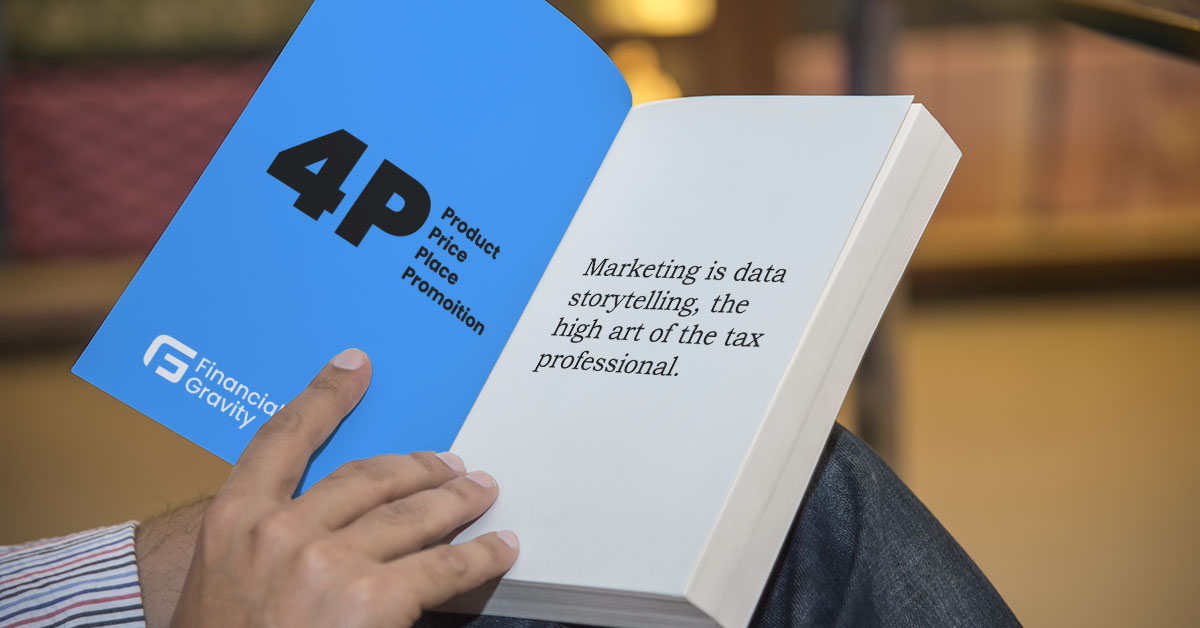In Part 1, we discussed the knowledge barrier and tried to make the point that CPAs possess a wealth of relevant, useful, and valuable knowledge about business, finance, and economics that many brokers, advisors, and insurance agents do not, and that is before even considering their knowledge of tax, forensic accounting, and data storytelling. The move to advising on wealth management will require new knowledge about regulations and financial products.
In Part II, we examined the infrastructure barrier, which is so significant in complexity and capital outlay that, as a practical matter, only partnering or outsourcing can overcome it. Here the CPA has a variety of choices, including turnkey multi-family office charters, which I would argue is their natural milieu. In some respects, this is actually the easiest barrier to overcome because others have removed it for you and can greatly speed the time to new, diverse revenues.
We discussed some basic but essential concepts in marketing in a recent blog, but here in Part III, we’ll examine marketing as a barrier to entry in wealth management services. Some CPAs minimize the importance of marketing as a barrier to their success, but that is exactly how they should be thinking of it. All the knowledge in the world, and world-class infrastructure, won’t do the entrepreneurial CPA much good if nobody knows about it, or if the branding that surrounds it is confusing, misleading, or undisciplined.
It may be useful for you to review that recent blog because marketing efforts should be thoughtfully targeted towards your ideal client. Many businesspeople unschooled in marketing as a profession make the mistake of chasing a market that’s too large and undefined. Maximum effectiveness in marketing comes from understanding the very specific problems your ideal clients suffer from. Ideally, only you can most effectively and economically solve those problems.
This is no trivial point. The common ingredient among all effective marketing efforts is empathy. Your marketing will succeed to the extent that you genuinely understand and relate to your prospective client’s pain points and to their decision-making process. Great marketing anticipates and overcomes potential objectives before they are ever raised.
There are some specific barriers to successful marketing, and you will need to deal with them all to maximize your productivity. These include developing your unique value proposition, creating your branding book, developing a marketing communications platform, creating an unending stream of collateral, and managing a business development program. None of this is easy, and all of it can be enormously time-consuming if you plan to do it yourself.
For the CPA, Marketing is Essential for Growth
I did not focus on knowledge of marketing in Part I, but the huge majority of CPAs I’ve known and worked with have invested little time in studying marketing, and most will admit they don’t know much about it. In my view, marketing is a profession, just as tax is, with its own language and best practices. This knowledge, whether you obtain it yourself or hire others who possess it, will be crucial to the ROI of your marketing expenses.
I’ve been conducting an anecdotal experiment for years. When in conversations with CPAs, which I have virtually every day, I ask them to tell me their unique value proposition. A vanishingly small number have any familiarity with the term, and among those that do, I’ve yet to meet any who can recite theirs. Some have asked if I mean elevator pitch, which is related, but none of them have had an effective, polished one of those, either. Some younger CPAs have heard of Simon Sinek’s “start with the why?”, which is actually a pretty simple formula, but again, I’ve yet to hear a single tax professional rattle of their why? statement.
I’d go so far as to say any of the three would be a great place to start overcoming your marketing barrier. It’s curious to me that CPAs have been seemingly reluctant to market their own business; perhaps their stern code of ethics and aura of quiet competence creates this reluctance.
Your unique value proposition serves to answer two vitally important questions for your marketing efforts: who are you that nobody else is, and what do you do that nobody else does? If there is something you do that no one else does, and there’s a group of people (or even just one) who need that thing, marketing’s job is simply to communicate this simple formula with that person or people.
You should ask second-level questions. Is it what you do, or the way you do it? Is there something about your process, or the experience of working with you, that’s unique? Or is there something about the terms of working with you? Is the total package you offer synergistic, or is it the most economic or convenient service in the marketplace? Let’s start with the premise that you are unique; there is only one of you. You will need to unlock this riddle. There are marketing consultants who will help you do it. They’re worth the money.
Is Your Brand on Autopilot, or Actively Managed?
When we think about your brand barrier, let’s start with the definition of brand. I’ve heard dozens of different definitions, but the one that rings true to me is this: your brand is the emotional connection between you and your clients. It’s how they feel about you. It’s how they react to communications about you, whether it’s running into them at the grocery store or getting a DocuSign package from your team. Feelings are immensely powerful things.
Your college or university has a brand, one you know intimately. You can name the school colors and mascot, and you know a lot about its history. None of that has any actual value for you, right? And yet it matters to you; these things create emotional triggers. When the development people reach out to you for a donation, they tug on these brand elements.
When that mail from your alma mater shows up, you instantly recognize it. This is true for all kinds of products and services you use and see every day. You often see a Dunkin’ very near a Starbucks, but for most people, one is strongly preferable to the other. The difference is their brand and how it affects you.
Your branding book will work wonders for you. Your communications will be recognizable, but there’s more. A disciplined brand strategy will convey a host of other, often subconscious, emotional effects. People are attracted to good design, and they will respond to images of iconic things. People will also equate brand discipline with thoroughness, competence, and discipline generally.
Elements of your branding book should include your color palette, typefaces and fonts, logos, tag lines, trademarked terms, and the essence of your images. Images of architecture create a very different reaction than images of families, for example. Your website, brochures, newsletters, blogs, and even your invoices and reports, should be fully consistent with your brand. Your branding book is your bible.
So far, the barriers have been mostly style elements. Your marketing communications platform is all about technology, and that will start with an element of your infrastructure, your CRM, or client relationship management platform. Your CRM is absolutely vital to your marketing.
Your CRM is where you will separate your contacts into categories, an essential step to effective communications. You will have many different kinds of clients; super-important ones, run-of-the-mill ones, tax-prep-only clients, bookkeeping clients, payroll clients, planning clients. Millionaire clients, others just getting by. You can categorize by demographics, revenues, geography, and a zillion other things. Each of these cohorts will have specific problems that you solve, or could solve. In fact, the ultimate approach to cohort development is by the problems and pain points they have.
All of these categories are applicable to your prospective clients as well. But, obviously, you will communicate very differently with clients and prospects. Your marketing communications platform should allow you to target different cohorts with different messages. Consider that Facebook Groups and LinkedIn Groups can supply you with ready-made prospecting cohorts. That is core to their revenue models, of course. Perhaps it should be core to yours as well.
Productivity is the big driver behind an effective marketing communications platform. Let’s say you want to update business owners on an important new IRS ruling that may affect them. With a good platform, you could write up an email and direct it just to business owners. Same for real estate investors, high-income earners, retirees, or self-employed individuals. Each of these groups has specific problems, and you want to target the problem, not the person. The last thing you want to do is comb through your contact list to tick off the recipients for your email.
There is a lot more to a quality marketing communications platform. It will give you extremely valuable information about the effectiveness of your marketing. What is your open rate? Your click-through rate? How long do people spend on your website? Which campaigns, subject lines, offers, calls to action, etc., are most effective? A really well-built platform will nurture respondents for weeks, gently reminding them that there’s something worth paying attention to.
This level of tech goes way beyond the typical two- or three-person tax shop. But there’s another way to think of it: it’s the way a two-person shop becomes an eight-person business, and it will spike your valuation for potential acquirers.
Socrates Could Write Messages with a Stick; CPAs Cannot
A marketing communications platform is simply a delivery mechanism. What it delivers, which we call your collateral, your messages, updates, newsletters, offers, announcements, and so on, is vitally important. Every message, no matter what its scope or content, is a moment of truth, a brand interaction. If the message is important or valuable enough, you could write in the dirt with the stick. But if the message is trivial, or poorly crafted, or badly timed, it may well work against you.
The other day, I received an email from a vendor that was addressed to “Dear xyz.” What do you suppose happened to my overall opinion of the vendor? Does that sort of carelessness make me feel more confident in their competence? The message might have been something like “here is a free $100”, but that xyz thing just soured the whole deal. Similarly, if I have a “Library” section on my website, and the last entry was from 2021, what does that do to my sense about the quality of that library? I’d be better off not having the section at all.
The collateral barrier can be very tough to overcome. Creating great collateral is part skill and part art, and it can be very time-consuming. The pressure to come up with fresh content can be a kind of tyranny, which is why so many people abandon their collateral efforts after the initial gout of activity to get their website up.
Like so many of the barriers facing tax professionals, developing your collateral may have to be outsourced. Outsourcing your tech can be relatively straightforward, but your messaging is much, much trickier. Your unique value proposition is, after all, unique. And more, if you’re asserting that you solve problems in a way others don’t, you can’t use off-the-shelf collateral. Someone has to craft your messages. If it’s you, bye-bye productivity; if it’s someone else, that’s going to cost real money. Among all the barriers to entry in wealth management for CPAs, marketing can be the most difficult and frustrating to solve.
We know that others have solved all of these problems; after all, there are tens of thousands of wealth management firms, from shade-tree asset managers to full-blown multi-family offices. One way or another, they have all solved the barriers problem. However, among all those firms, there are some who enjoy robust growth, and many who do not. The difference is in the quality of their business development program.
With Marketing, You Won’t Get What You Won’t Pay For
A useful experiment for any CPA is to review their calendar for the period between May 1st and August 31st. Let’s say you worked 40 hours per week during that period, and there were 20 weeks. Of those 800 hours, how many did you spend actively engaged in business development? Did you host any seminars or webinars? Did you host any events? Did you manage an outbound advertising program? Are you part of a networking group, or are you engaged in civic/social groups like Rotary Club?
I can tell you already that the median number of hours spent in this prime business development season is less than 10. That works out to about one percent of your available time. Now calculate what your total spend on business development was. I’m guessing the median spend was well under $1,000. For a large percentage of CPAs out there, the total time and the total spend were equal to zero. They rely entirely on word-of-mouth referrals from existing clients.
My suppositions above are anecdotal, and I know there are some real go-getters out there. I will suggest to you that CPA’s businesses are no different from any other business: the correlation between effort and results is nearly absolute. Growth costs time and money, but growth also produces new revenues and profits. Growing businesses are also more valuable in the marketplace.
The marketing barrier is overcome with investments in time and money. Fortunately, there are firms that appreciate the unique value that CPAs provide in holistic wealth management, and have built done-for-you partnership programs that are available on a low-cost, subscription basis. It essentially comes down to this: you can join a wealth management firm, or it can join you.















